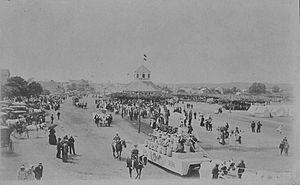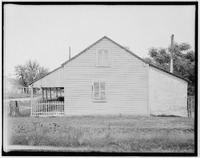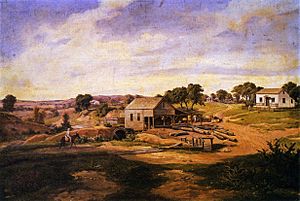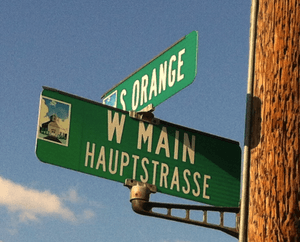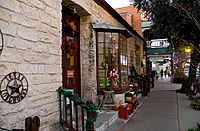History of Fredericksburg, Texas facts for kids
The History of Fredericksburg, Texas begins with its founding in 1846. The town was named after Prince Frederick of Prussia. Fredericksburg is also known for Texas German, a special way of speaking German. This dialect was used by the first German settlers who did not want to learn English. Fredericksburg shares many traditions with New Braunfels, which was started a year earlier by Prince Carl of Solms-Braunfels.
Contents
Fredericksburg's Early Days (1800s)
Fredericksburg, or Friedrichsburg in German, was founded in 1846. It was started by Baron Otfried Hans von Meusebach. He was the new leader of the "Society for the Protection of German Immigrants in Texas." This group was also called the "Noblemen's Society." Many Germans came to Texas to escape problems in their home country. These problems later led to the Revolution of 1848. Baron von Meusebach gave up his noble title in Texas and became known as John O. Meusebach. A local stream, Barons Creek, was named after him.
The Meusebach-Comanche Peace Treaty
John O. Meusebach was called El Sol Colorado, meaning "The Red Sun," by Penateka Comanche Chief Ketemoczy. This was because of Meusebach's reddish-blonde hair. In 1847, Meusebach and his group met with the Comanche leaders. They made a special agreement called the Treaty between the Comanche and the German Immigration Company.
This treaty was very unique. It did not take away the rights of the Penateka Comanche people. Instead, it was an agreement for both the Comanche and the settlers to share the land. They promised to live together in peace and friendship. Meusebach paid the Penateka Comanches with food, gifts, and other goods. This treaty is one of the few with Native American tribes that was never broken.
The Easter Fires Tradition
The Easter Fires pageant in Fredericksburg has two origins. In Germany and the Catholic Church, people light bonfires on hills around Easter. This celebrates the arrival of spring.
The Fredericksburg version also celebrates the signing of the 1847 Meusebach-Comanche Treaty. The treaty was signed after Easter, but the final talks happened in early March. The legend says that the Penateka Comanches lit huge fires on the hills. They used these fires to signal each other about the treaty talks. Settler mothers told their children a fun story to calm them. They said the fires were lit by bunnies boiling water to make eggs for Easter morning. Some versions say the bunnies were boiling Texas wildflowers to color the eggs.
The pageant usually happens the Saturday before Easter. It shows the signing of the treaty. People dressed as bunnies light fires on the hills. This show has been a big attraction since 1946. Recently, the pageant was stopped due to costs, but people are trying to bring it back.
Starting the Town
In 1845, Meusebach left New Braunfels. He traveled about 60 miles (97 km) to find a spot for the second settlement. He chose a valley between two creeks, now called Barons Creek and Town Creek. Seven hills surrounded this area. He named the town after Prince Frederick of Prussia. This prince was a high-ranking member of the Mainzer Adelsverein. Meusebach bought 10,000 acres (40 km2) of land on credit. Each settler would get one town lot and 10 acres (40,000 m2) of farmland.
In December 1845, a road was built from New Braunfels to Fredericksburg. The town was planned by surveyor Herman Wilke. On April 23, 1846, the first group of settlers left New Braunfels. They met friendly Delaware Indians on their way. They arrived at Fredericksburg on May 8, 1846. The first colonists quickly planted a garden. They also built a log storehouse, a stockade, and a blockhouse.
The settlers soon got a message from Governor James Pinckney Henderson. He warned them that Mexico's actions made it unsafe. He advised them not to move into the area. But the settlers refused to go back to New Braunfels.
Meusebach chose Dr. Friedrich A. Schubbert to lead the new colony. Schubbert led a second group to Fredericksburg in June 1846. He designed the Vereins Kirche, which was the first public building in Fredericksburg. Later, Schubbert led an armed group into Comanche land without Meusebach's permission. Shawnee scouts reported seeing many Kickapoo near the Llano River. Schubbert's group went back to Fredericksburg. Meusebach then decided to go into Comanche territory himself. This led to the peace treaty with the Penateka.
In January 1847, Ferdinand von Roemer visited Fredericksburg. He thought about six hundred people lived there. He described the town as having about fifty houses and huts. They were spread out along the main street. Most houses were made of logs. Many settlers lived in huts made of poles, clay, and moss. Some even lived in linen tents, which were not good in winter.
Roemer said people ate bear meat, corn, and coffee. He noted that dysentery was common. He also mentioned a "stomachache" disease that affected lungs and throat. It was treated with citric acid but still caused deaths daily.
Schubbert tried to take control from Meusebach but failed. Many colonists signed a paper asking Meusebach to stay. On July 12, 1847, Meusebach fired Schubbert. Jean Jacques von Coll became the new director. Coll was a retired officer who had been a financial officer in New Braunfels. He later became mayor of New Braunfels in 1852.
On December 15, 1847, people asked to create Gillespie County. In 1848, the government formed Gillespie County from Bexar and Travis counties.
Most people who signed were German immigrants. But there were also Spanish and Anglo names.
The first sheriff of the county was Louis (Ludwig) Martin. He came from Germany in 1844 and moved to Fredericksburg. He signed the paper to create Gillespie County. He became District Clerk in 1850.
Wilhelm Victor Keidel was the area's first doctor. He came from Germany. He was elected the first Chief Justice in 1848.
Theodore Specht became the first Postmaster of Fredericksburg on December 7, 1848. Specht was from Germany. He and his wife, Maria Berger, came to Fredericksburg in 1846. The Spechts ran a store from their home. Penateka Comanches often visited it. Local Comanche chief Santa Anna even brought one of his wives there to give birth.
Pioneer Flour Mills was started in Fredericksburg in 1851. Carl Hilmar Guenther, an immigrant from Germany, founded it. He served as Justice of the Peace in 1856. In 1859, after two years of dry weather, the Guenther family moved their mills to San Antonio.
Fort Martin Scott Incident
On July 1, 1850, a group of fifty soldiers from Fort Martin Scott burned down the store-courthouse in Fredericksburg. This happened during a fight with the store owner, John M. Hunter. The soldiers were angry because he refused to sell whiskey to a soldier. The soldiers also stopped townspeople from saving the county records.
Civil War and Reconstruction Era
During the Civil War, Fredericksburg mostly supported the Union. However, some people in the town were loyal to the Confederacy. Many Germans thought slavery was wrong. But the 1860 census showed thirty-three enslaved people in Gillespie County. Matthew Gaines was an enslaved person who escaped. He was captured in 1863 and forced to work in Fredericksburg during the war. After he became free, he moved away and was elected to the Texas Senate. In 1877, the Colored Methodist Episcopal Church served as a church and school for Black families.
People in the town faced a lot of lawlessness during and after the war. A school teacher named Louis Scheutze was taken from his home and hanged. People thought James P. Waldrip did this because Scheutze spoke against the Confederacy. Waldrip was believed to be part of a group called Die Haengebande (Hanging Band). This group took justice into their own hands. Waldrip was also a known thief and was not liked by many. In 1867, someone shot Waldrip outside the Nimitz Hotel. He was buried secretly to prevent his grave from being disturbed.
Fredericksburg in the 1900s and 2000s
In 1904, Fredericksburg had about 1,632 people. Frank Stein built the town's first ice factory in 1907. From 1913 to 1942, the Fredericksburg and Northern Railway connected Fredericksburg to Waring. Fredericksburg officially became a city in 1928.
For the first half of the 1900s, Fredericksburg was like other German farm towns in the Texas Hill Country. It was mostly separate from outside influences. Only a few visitors came for events like Easter Fires or hunting season. The town's population and growth stayed true to its local roots.
Things started to change when Lyndon B. Johnson became Vice President of the United States. A very important event happened on April 16, 1961. Johnson, Fleet Admiral Chester Nimitz, and the first leader of West Germany, Konrad Adenauer, arrived by helicopter. They landed at the Fredericksburg fairgrounds racetrack for a reception. They were joined by U.S. Congressman O. C. Fisher and John O. Meusebach's last living child, Mrs. Ernest Marschall. Between 7,000 and 10,000 people came to see them. This was a lot, as Fredericksburg's population in 1960 was only 4,629.
Many family members, German officials, security, and national media came with the important guests. Speeches were given in English and German, and no translation was needed. A singing festival, called a saengerfest, was part of the event. Chancellor Adenauer even sang along with the children's choir. The Fredericksburg High School Band also performed. The event ended with a tour of Fredericksburg. Nimitz visited his relatives instead.
When Lyndon Johnson became President on November 22, 1963, the world looked at his Texas White House nearby. The Nimitz Hotel in Fredericksburg became the media's headquarters. Reporters shared good things about the area in their news. The Johnsons went to church in Fredericksburg. The President often showed important guests around the town. West Germany Chancellor Ludwig Erhard visited Fredericksburg in 1963. He was greeted with "Herzlich Wilkommen" (Welcome) and heard a sermon in German. During Johnson's time as Vice President and President, Fredericksburg grew from tourism. It changed from a quiet community to one that welcomed tourists.
Fredericksburg has also benefited from tourism from nearby Luckenbach. This small town became famous after a few events. Jerry Jeff Walker recorded his album Viva Terlingua there in 1973. In 1977, Waylon Jennings and Willie Nelson recorded their hit song Luckenbach, Texas (Back to the Basics of Love). Also, the National Museum of the Pacific War brings many military history fans to Fredericksburg.
Fredericksburg has become a popular place for people to retire or move for a simpler life. Real estate has become a big business, and prices have gone up. The city is now a popular weekend trip for people from Central Texas, especially from Austin and San Antonio.
In the 21st Century, Fredericksburg is changing. As the families of the first settlers move away or pass on, the original German farm culture is slowly fading. It is mixing with the customs of new people moving in. It is also being replaced by tourist ideas of both German heritage and Texas cowboy culture. In 1934, the Gillespie County Historical Society was formed. It now has over 300,000 historical items. This society and other groups work to save the artifacts, buildings, and history of Fredericksburg.
Images for kids



